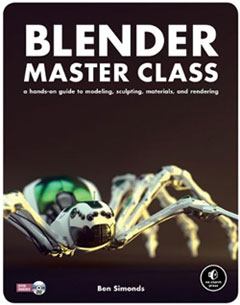
![]()
Blender Master Class: A Hands-On Guide to Modeling, Sculpting, Materials, and Renderingby Ben SimondsNo Starch PressFebruary 2013, 288 pp., w/DVDUS$49.95 Print Book and FREE Ebook$39.95 Ebook (PDF, Mobi, and ePub)
Blender Master Class is a must-have for anyone who uses or even plans to use the Blender graphics tool. It is a learn-by-doing guidebook that takes all the frustration and guessing out of the Blender equation.
Author Ben Simonds does a marvelous job of taking the wonder out of using the powerful Blender features. He is a professional 3D artist and co-director of Gecko Animation Ltd., a post-production and computer animation company based in London. His active role in producing high-level graphics for professional clients and television audiences pays off in writing this book.
Blender is a highly specialized and powerful cross-platform 3D graphics rendering application. It is an open source — thus free — software package. But do not let that cast aspersions on its worth. As is the case with most open source products, the adage that you get what you pay for does not apply. Blender matches features and performance of the leading commercial equivalent software packages.
That said, Blender Master Class is well worth its price. Simonds taps into his vast experience in creating inspiring artwork to take you step-by-step through three complete graphics creation projects. When you finish the practice lessons, you will have little difficulty applying what you have learned to create your own graphics masterpieces.
Art-Based Learning
Simonds’ three practice projects are a muscle-bound gargoyle, a futuristic robotic spider, and an ancient temple in ruins overgrown with jungle. These tasks are significant accomplishments.
Doing them at your own pace gets you through the usual barriers new users face in learning Blender skills. Blender is a 3D graphics tool used by artists and designers worldwide, but even experienced designers can find it challenging to turn an idea into a polished piece in Blender.
This is where Blender Master Class excels. Professional strength rendering software is not a tool for tinkerers. As you work your way through Simonds’ instruction, you advance from the ranks of Blender bumbler to Blender benefactor.
A Pleasant Read
Blender Master Class looks like a technical textbook. Looks, however, can be deceiving. It does not read with the stuffiness you would expect in a guidebook peppered with topic headings and multi-part color illustrations.
Instead, Simonds takes a down-to-earth approach that reads as though he were sitting next to you at the computer, talking you through each step. This is very effective in keeping you engaged in the learning process, while snickering at times at his explanations about his graphics projects for actual TV studios in the UK.
His mastery with Blender and graphics creation combines with an expertise in communicating ideas. In each chapter Simonds tells you what you will learn, what to do to learn it, and what you have learned at the end of the chapter.
Content Capable
The book is divided into 15 chapters. Each one focuses on a specific set of tasks. As you progress through the chapters, you recognize how the skills previously learned prepare you to use the more advanced tool sets that Blender offers.
For example, in the initial chapters you learn how to block in models with simple geometry and build up more complex forms. To add to that skill, you learn to use Blender’s powerful sculpting brushes to create detailed organic models. Then you tackle paint textures and map them onto your 3D artwork. After mastering that, you learn to use light, render and composite in your models to create striking images.
Simonds uses an effective game plan. In each chapter, he walks you through a piece of the modeling process and offers detailed explanations of the tools and concepts used. Each chapter is filled with full-color artwork and real-world tips. All of this contributes to giving you a solid foundation to create your own stunning masterpieces.
GIMPing Along
Simonds shows his real insight into the world of graphic creation. Before Blender users can effectively function with its models, they need familiarity with a companion graphic editing tool. The author cleverly slides in a tutorial in using GIMP (the GNU Image Manipulation Program) in Chapter 2.
Why? Blender’s original purpose was graphics creation, not image editing. It was designed as a 3D animator/compositor with advanced capabilities. That means its users need competence in editing 2D graphics files in another application. GIMP is a free, open source replacement to the commercial graphic editing standard, Adobe Photoshop.
In creating materials to use within Blender, Simonds takes his readers through the process of preparing reference images, creating textures for models and alphas for sculpting brushes. He also has readers add some tweaks to their final renders. Though Blender does have 2D painting tools within the UV Image editor, something more capable is needed that is geared toward editing images, Simonds explains.
“GIMP is just such a tool, and it makes for an excellent companion application to Blender when creating 3D digital art,” he tells readers in introducing GIMP.
Extra Materials
The print version of Blender Master Class comes with a DVD. This medium provides very useful materials to enhance the reader’s learning curve in gaining mastery over Blender. The DVD includes files for each project in the book, as well as extra textures, brushes and other resources.
Blender Master Class covers Blender 2.6x. But this book’s content or usefulness will not become outdated any time soon. The concepts it establishes provide a working knowledge of how Blender works. Future revisions to the Blender software will merely build on the skills the book teaches.





















































